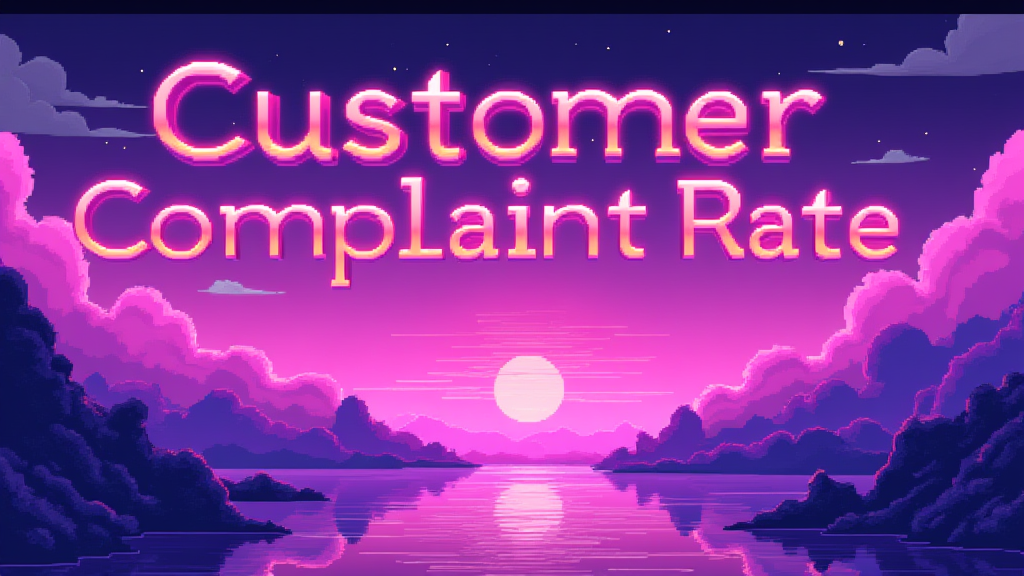Customer Complaint Rate: Key Metric for Success

Published on: October 01, 2024
What is Customer Complaint Rate?
Customer Complaint Rate is a metric that measures the percentage of customers who have lodged formal complaints about a product, service, or overall experience with a company. It is typically calculated over a specific period, such as monthly or quarterly.
The formula for calculating Customer Complaint Rate is:
$\text{Customer Complaint Rate} = \frac{\text{Number of Complaints Received}}{\text{Total Number of Customers}} \times 100\%$
Why is Customer Complaint Rate Important? 🎯
Monitoring and analyzing the Customer Complaint Rate is crucial for several reasons:
- Customer Satisfaction: It directly reflects the level of customer satisfaction with your products or services.
- Quality Control: Helps identify recurring issues or areas that need improvement.
- Brand Reputation: High complaint rates can negatively impact your brand's reputation.
- Customer Retention: Lower complaint rates often correlate with higher customer retention rates.
- Operational Efficiency: Analyzing complaints can lead to process improvements and cost savings.
Interpreting Customer Complaint Rate
While the ideal Customer Complaint Rate is 0%, it's essential to understand what constitutes an acceptable rate for your industry. Here's a general guideline:
| Rate | Interpretation |
|---|---|
| 0-2% | Excellent |
| 2-5% | Good |
| 5-10% | Average |
| >10% | Needs Improvement |
Keep in mind that these ranges can vary depending on your specific industry and customer base.
Strategies to Reduce Customer Complaint Rate 📉
Implementing the following strategies can help lower your Customer Complaint Rate:
- Improve Product Quality: Regularly assess and enhance your products or services based on customer feedback.
- Enhance Customer Service: Train your support team to handle complaints effectively and empathetically.
- Implement Proactive Communication: Address potential issues before they escalate into complaints.
- Streamline Processes: Identify and eliminate bottlenecks in your operations that may lead to customer dissatisfaction.
- Gather and Act on Feedback: Regularly collect customer feedback and use it to drive improvements.
Common Misconceptions about Customer Complaint Rate
It's important to avoid these common misconceptions when dealing with Customer Complaint Rate:
- Low complaint rate always means high satisfaction: Some dissatisfied customers may not complain, leading to a false sense of security.
- All complaints are bad: Complaints can provide valuable insights for improvement and show that customers care about your product or service.
- Complaint rate is the only metric that matters: While important, it should be considered alongside other customer satisfaction metrics for a comprehensive view.
By understanding and effectively managing your Customer Complaint Rate, you can improve customer satisfaction, enhance your brand reputation, and drive long-term business success. 🚀
Implementing Customer Complaint Rate in Your Strategy
To effectively use Customer Complaint Rate in your Sales or Marketing strategy, consider asking yourself these questions:
- How does our current Customer Complaint Rate compare to industry standards?
- What are the most common types of complaints we receive, and how can we address them?
- How can we improve our complaint resolution process to increase customer satisfaction?
- Are we effectively using complaint data to drive product or service improvements?
- How can we integrate Customer Complaint Rate with other customer satisfaction metrics for a more comprehensive view?
By regularly reviewing these questions and taking action based on the answers, you can leverage Customer Complaint Rate to drive continuous improvement in your organization.
















